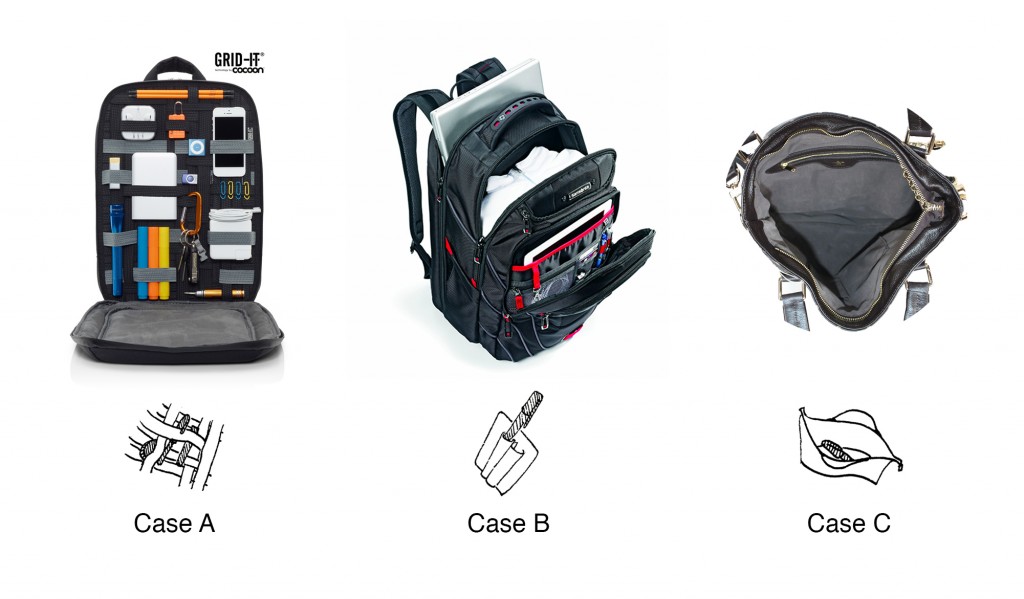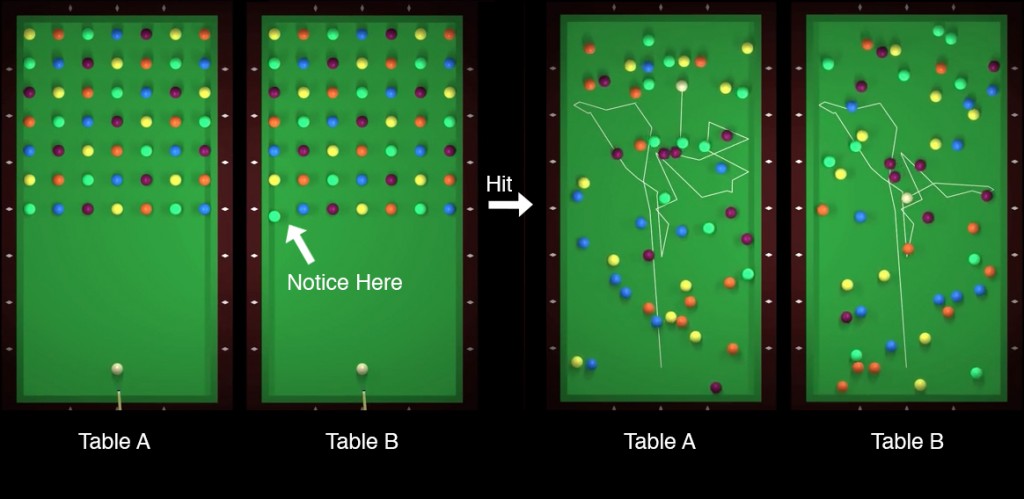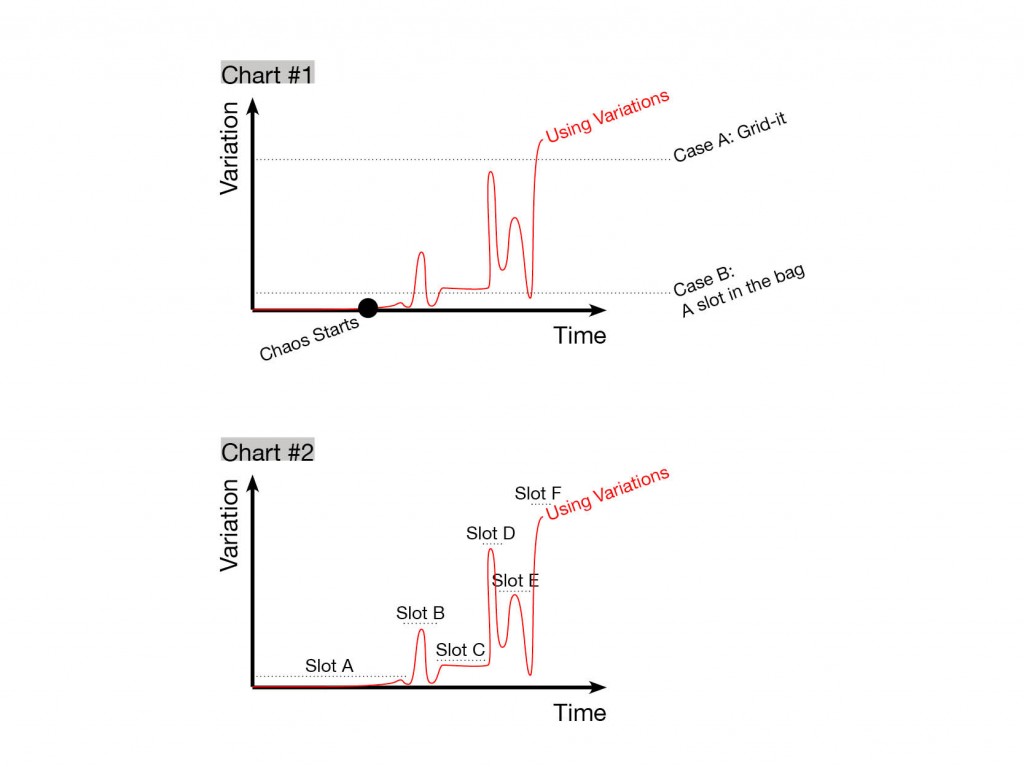A Bottom-up Backpack
Posted on December 19, 2014
GRID-IT
The other day, my bag was broken. Right after I got the conclusion that I can not live without a bag, I pressed the “ CHECK OUT” within several alternatives with one-day deliver by paying extra dollars on the Apple online shop. Next day, I got this bag, branded Cocoon. As Alexander Osterwalder & Yves Pigneur wrote on their book Business Model Generation, “The Value Proposition is the reason why customers turn to one company over another. It solves a customer problem or satisfies a customer need.” [1]. As for me, the leveraged point of this bag is the value it provides: Grid-it (Figure1, CaseA). Here is a short elaboration from Engadget about how Grid-it functions “what hooked me the moment I saw it — is the “grid-it” system in the second compartment. Basically, criss-crossing elastic straps make this an infinitely configurable gadget holder. Most of the bands are quite tight and thus better-suited for small items, but there are a few looser ones that let you tuck in larger items as well. I can get everything in from USB sticks right up to my NEX 3 camera. It’s a bit of a Fort Boyard-style puzzle to cram everything in the relatively small space, but that’s all part of the fun, I guess.” [2]
Honestly, I spent a lot of time to find out the different ways to grid my gadgets, for instance, the most ascetically one, the most convenient one that allows me pick my keys, or the most essential one. Compare to most bags, problems common with many of them are imperfect pocket sizes or too much overall bulk (Figure1, CaseB&C). With either bag, having too many items leads to clutter, and those who have only a handful of gadgets end up with too much excess bag space.
After tested several way of grid-it, I went to the dunkin donuts for awarding myself. While drinking my Latte, I have a glance at my plastic cup, I asked myself: If there is a Grid-it version of the plastic cup, then what will it looks like? I started to draw some concepts but could not figure out anything worthy until I realized the fundamental difference between Grid-it and a normal bag with a slot for a Sharpie lies in who you are designing for. In a normal bag’s case, designers designed a slot whose size is perfectly fir to the sharpie that a user bought in 2014, in short: the slot designs for sharpie. Grid-it, on the other hand, designs with the packing behavior itself, thus the objects to be packaged varies from a pen to a camera for instance.
IMPERIALISM AND TACTICS
In fact, the differentiation between Grid-it and a normal bag not only lies on the intention of the users, but far more than that. As Bruce Nussbaum questioned in the article Is Humanitarian Design the New Imperialism? Does Our Desire to Help Do More Harm Than Good?, “Do designers need to better see themselves through the eyes of the local professional and business classes who believe their countries are rising as the U.S. and Europe fall and wonder who, in the end, has the right answers?” [3] These questions based on the criticize of purely empirical design. In the context of a normal bag, then a designer may design a slot for one sharpie without research the real needs of the users, because he designs empirically. Another reference from Certeau, Michel de. The practice of everyday life, In this book, he differentiates two ways of operating in a space: strategy and tactics. The strategy is linked to institutions and structures of power, using formal and top-down forces to act. Tactics, on the other hand, mean the artifices and everyday acts of ordinary people. They are not a discourse, but rather a genuine move, a constant game with the situations in order to transform them into occasions to act. [4] The reason that Tactic and Strategy attracted me lies in a self-question: Have the designer who designed Grid-it predicted the each possibility that how user interact with Grid-it? After learned from tactic, I probably see the answer is no. Different from design intentionally like designing a slot in a bag, Grid-it is much more like a playground that stimulate emergence behaviors of users. But is a system like Grid-it is perfect? Or how long it could last?
CHAOS
While I was watching a documentary called Chaos by Jos Leys, Étienne Ghys, Aurélien Alvarez [5], I felt been empowered to try answering this question. In the first chapter, The documentary talks about the Butterfly Effect. The whole notion is about a tiny change of initial setting could post a tremendously different result in future. It takes an example (Figure2), Imagining there are two billboards table with balls settled exactly the same except the green one has been move downward 1cm on the Table B. After hitting the white ball with exactly same force and direction, there is a certain point that the trajectory of the white balls are no longer the same. And that is when visible Chaos happens.
Inspired by billboards and the questions reminded before, I tried to draw this diagram: In the Chart1 (Figure3), Vertical and horizontal axises are possible ways to package your stationeries in your bag and time respectively. So we have Grid-it and a typical slot. Before the chaos happens, everything is fine because it is so close to predict. However, it is easy to trigger a chaos as long as either sharpie changes it’s size in future, or the user decided to use two sharpie but not one, or even the user just want use a dry marker tomorrow. In either one case mentioned above, the slot designed for sharpie does not work, on contract, Grid-it is so flexible to confront the uncertainty, and design with user every time when you try to adjust a new gadget. In the Chart2, it shows for a traditional “Design for” approach, that requires multiple specific slots to address every single emergent stationeries.
In the end, we could probably say compare to a traditional design for strategy, Grid-it is a open platform to emergent your way to package your gadgets tactically. Undoubtedly, the Grid-it still have the limitation as every system has, but more resilience, self-orignized and hierarchy. [6]


